Travel Report: The DMZ, Korea.


The DMZ, South Korea.
February 2015. “What the hell is a DMZ?” a friend of mine asked over Facebook Messenger. Hm, not quite the excited reaction I was hoping for. Not that I could blame him, as such. I hadn’t been aware of the particulars myself prior to researching my trip to South Korea.
Time and time again, The DMZ Bus Tour came up on lists of essential sights near Seoul. Thus I began reading up on the history of South Korea’s infamous DMZ and immediately found myself hooked.

A civilian entry checkpoint on the South Korean side of The DMZ.
Photo courtesy of Johannes Barre.
To answer my friend’s question, a DMZ is a demilitarised area that serves as a buffer zone between two countries. The Korean Demilitarised Zone was created in 1953 following The Korean Armistice Agreement.
Signed by North Korea, China and The United Nations Command, its purpose was to achieve a ceasefire between The North and The South, marking an end to the hostilities of The Korean War.

Signing the Korean Armistice Agreement. July 27th, 1953.
Photo courtesy of the US Department of Defense.
Interestingly, South Korea didn’t sign the agreement. This was due to the fact that then President Syngman Rhee saw his signature as a formal acceptance that he’d failed to unify Korea by force. What a character.
The DMZ, Korea.

The DMZ Korea Bus Tour.
Fast forward sixty seven years and, yup, The DMZ continues to tick along as a neutral zone between the two countries. Moreover, it has even become one of the world’s most surreal tourist attractions.
I arranged my visit through the United Services Organizations (USO), a non-profit group that provides a range of social services to members of the United States Armed Forces.

Camp Kim, Seoul.
My day trip to The DMZ began at Camp Kim, an American military facility in central Seoul. There were about twenty of us on the bus that day, including people from The UK, The USA, The Netherlands, India, Belgium, Mexico and Australia.
It was a chilly, grey February morning, but warm enough inside the bus as we made the fifty kilometre journey to the first of The DMZ’s many check points.
Dora Observatory.

Dora Observatory, The DMZ, Korea.
As we passed through the various security stations, our guide gave us a potted history of The DMZ, until we pulled up outside Dora Observatory. Inside, we sat down in a small theatre to watch some archive footage of the DMZ’s creation and then subsequent expansion over the years.
Then, much to the horror/amusement (delete as applicable) of various group members, our guide asked us to sign a no liability agreement. Basically, it insists, if the shit goes down and someone happens to be shot or blown up, nobody takes responsibility. #lovely

No liability!
The DMZ, Korea.
With all our agreements signed, the guide ushered us to the actual observatory, which has sweeping views over The DMZ. It was yet another hazy day, hence the panoramic wasn’t quite as impressive as I’d expected.

The DMZ, Korea.
Nevertheless, I grabbed a pair of binoculars and zoomed in on the general desolation. It’s an exceptionally eerie, almost hopeless landscape, especially on that day in the enveloping gloom. On a clear day, our guide said, it’s possible to see the skyline of Kaesong, a North Korean city. Just my luck.

DMZ views from Dora Observatory.
From Dora Observatory, we made the short drive to Dorasan Railway Station, which used to connect North and South Korea. Opened in 2002, it has mainly served as a freight line and sits just six hundred and fifty metres from The DMZ’s southern boundary.

Dorasan Station.
It was a creepy experience passing through the empty station hall and onto Dorasan’s only functioning platform.

The platform at Dorasan Station.
In the distance, slowly plodding towards me, was this stern South Korean soldier. I was half thinking of giving him a wave, at which point a voice in my head screamed: NO LIABILITY. Call me crazy, but I just had to get a photo. Yes, I was very discreet.
Dorasan Station.

The DMZ, Korea.
In December 2007, DMZ personnel helped implement a special freight train service from Dorasan to the north’s Kaesong Industrial Region. At the time this was considered a huge breakthrough in relations!
The joint agreement allowed South Korean companies to hire cheap North Korean labour, while workers from the north gained access to foreign currency and improved wages. The region was home to electronic warehouses and precision machinery factories, among other enterprises.
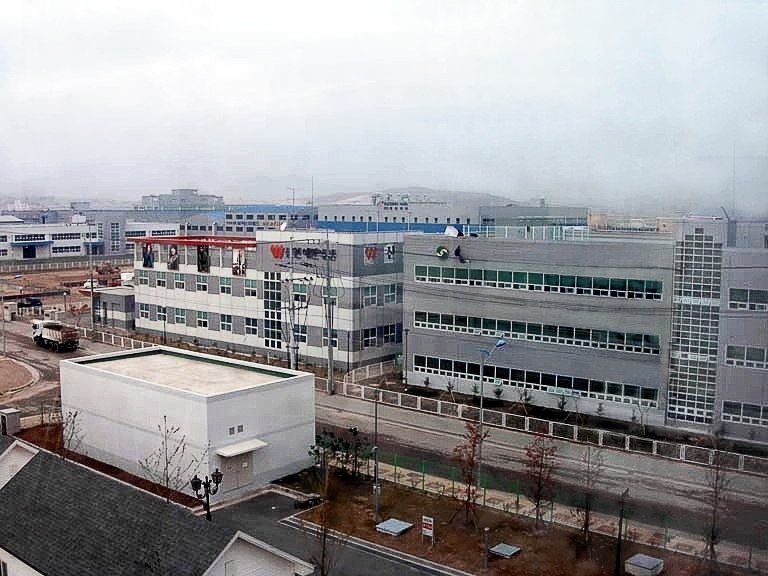
The Kaesong Industrial Region.
However, just under a year later the North Korean government suddenly closed the border crossing. A statement swiftly followed, in which The North accused The South of “confrontational behaviour”.
They were referring to South Korea’s recent legislative election, which involved transitioning into a more conservative government. Since 2008 the freight service has reopened and closed on countless occasions, due to periodic frictions.

The DMZ Train.
Today a special train service from Seoul allows tourists to come and see Dorasan Station. They ride on the very cool DMZ Train, aka The Peace Train, in operation since 2014.
The carriages are full of garish images of peace and war, side by side. I’m literally talking flowers, bunny rabbits and children holding hands alongside military helmets, grenades and firing machine guns. For a full review of The DMZ Train experience, check out this article by roamingaroundtheworld.

The DMZ, Korea.
Dorasan Station is certainly a unique sight. A big old empty hall and a ghostly platform seemingly poised for a return to business, should its neighbours wish it. As such, the station seems to stand as a symbol of hope for an eventual reunification.
Dora Restaurant.
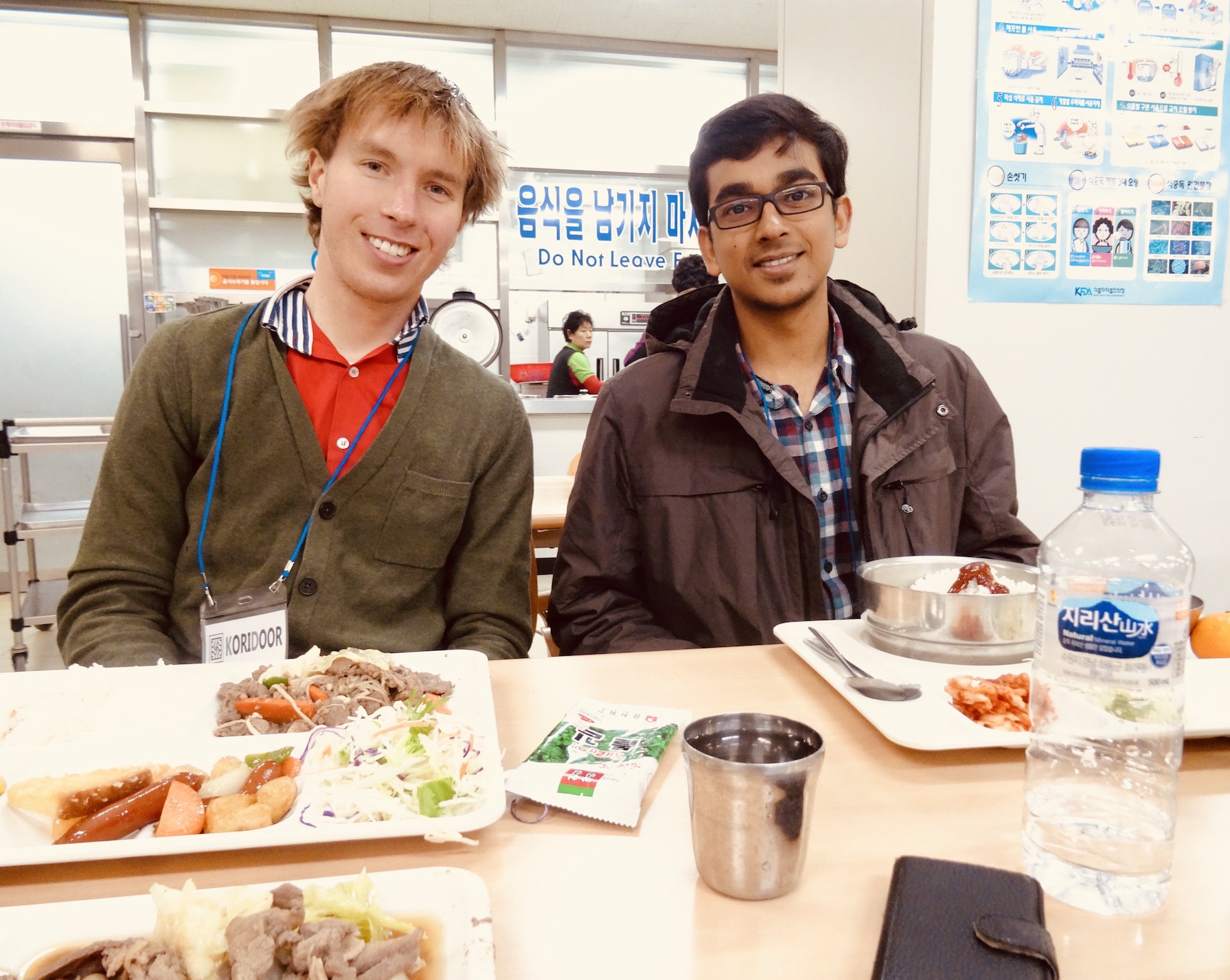
Dora Restaurant.
If we thought the train station was weird, how about Dora Restaurant, a giant canteen that serves all DMZ personnel, along with hungry tourists. Lunch that day, a sloppy mix of meat, vegetables, noodles, rice and fruit, came free with the tour.
The food was staggeringly average, but it did give me the chance to chat with two of my fellow tour members, Riva from India and Jelmer from The Netherlands.

The DMZ, Korea.
When eating at Dora Restaurant, there’s one very important rule you have to keep in mind. Absolutely, under no circumstances, are you to put more on your plate than you can eat. In fact, they have a strict zero waste policy.
Break this rule and you’ll have to answer to this lady. “Maybe she will throw you into North Korea” joked our guide. As a result, I took care not to leave so much as a stray noodle when I returned my tray.
The Third Tunnel of Aggression.
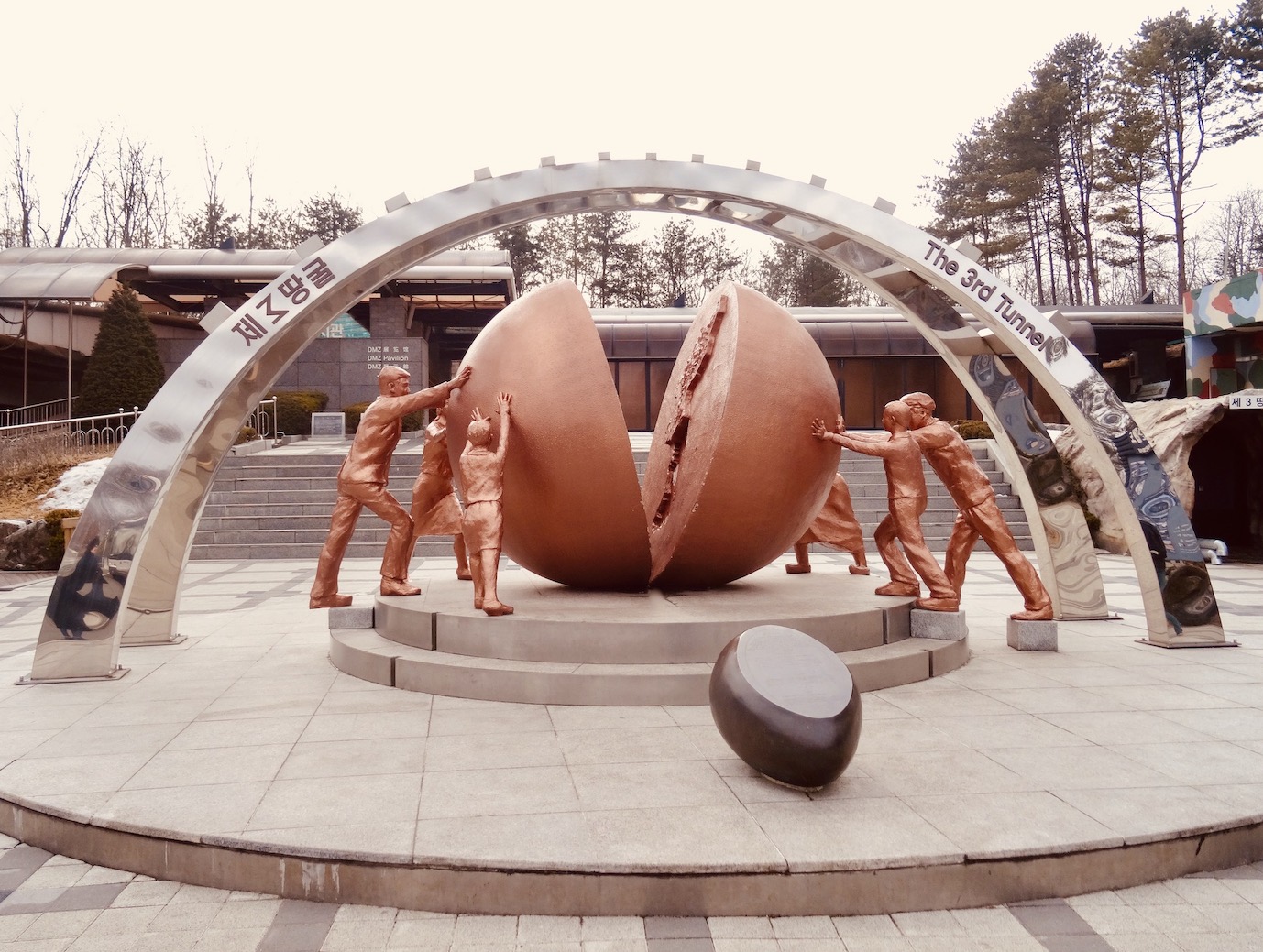
The 3rd Tunnel Complex.
There are four known tunnels under the border between North and South Korea. The incomplete 3rd Tunnel, also called The Third Tunnel of Aggression, was discovered in October 1978 after a loud underground explosion.
North Korean tunnellers, who had progressed 435 metres under the south side of The DMZ, accidentally caused the explosion, perishing in the process.
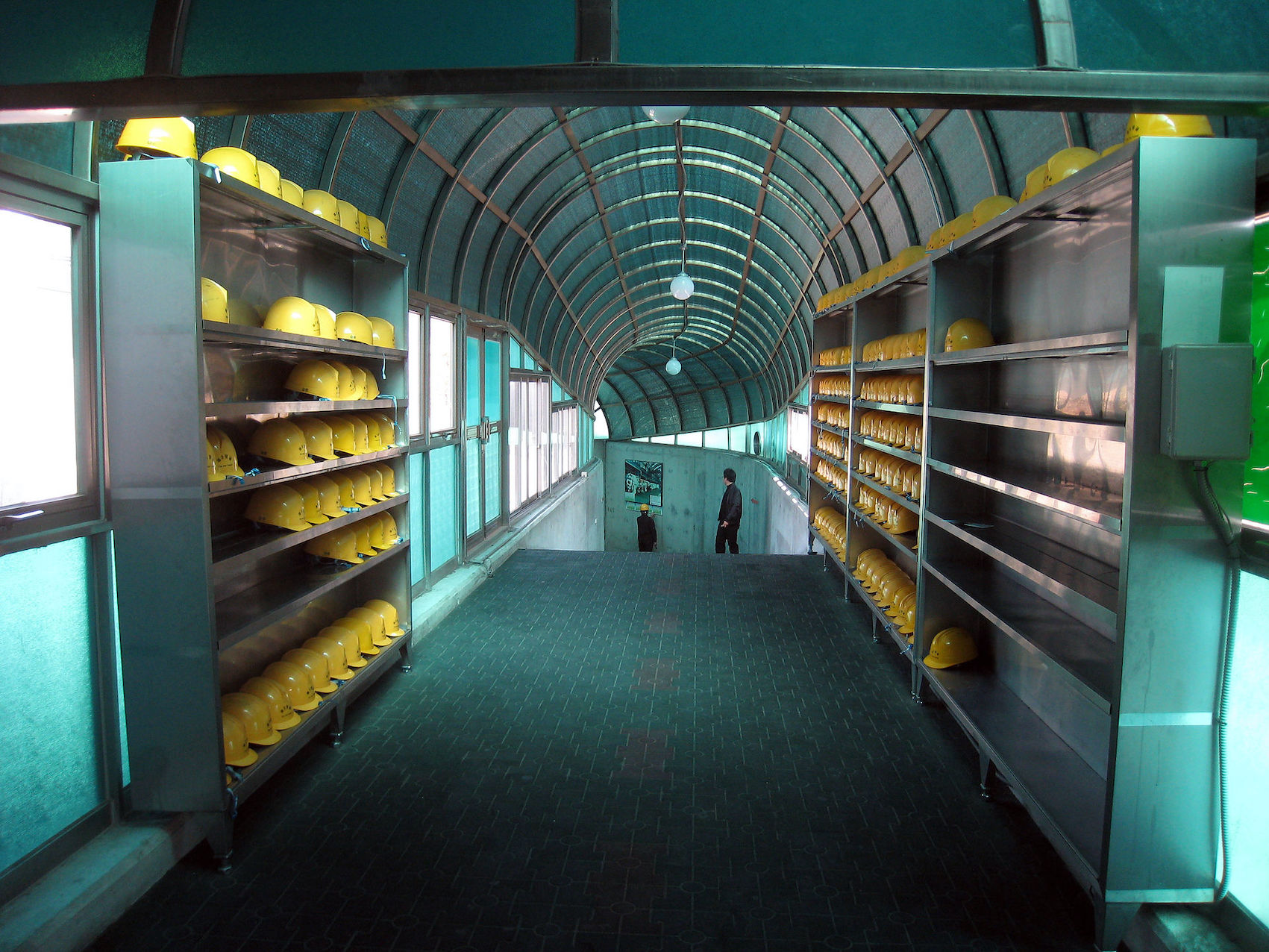
Entrance to The 3rd Tunnel.
Photo courtesy of Josh Berglund.
It took four months for DMZ personnel to locate the tunnel, after which they constructed an intercept tunnel. Apparently, the original tunnel was capable of accommodating thirty thousand men, in addition to light weaponry.
Concluding that it had been built to launch a surprise attack on Seoul, The United Nations Command accused North Korea of threatening the 1953 Korean Armistice Agreement.

Having originally denied building the tunnel, North Korea later claimed it was a coal mine! Despite the fact that the tunnel walls are made of granite. That afternoon we actually got to put on a yellow safety helmet and walk through a short section of the tunnel. A fascinating and bizarre experience.
The DMZ, Korea.

The Joint Security Area.
Back on the bus and we were soon pulling into what is definitely the highlight of the tour. This is the JSA (joint security area), used by the two Koreas for diplomatic engagements.
It’s the only section of The DMZ where North and South Korean soldiers stand face to face, on either side of the demarcation line. The scattered blue buildings are meeting rooms, forming what is referred to as Conference Row.

The JSA.
The tension was palpable that day as I stepped off the bus. A number of South Korean officers stood staring down a sole North Korean soldier, positioned at the entrance of Phanmun Pavilion.
That day, the South Korean soldiers all had pistols, along with a black belt in either Judo or Taekwondo. Today, all soldiers in the JSA stand unarmed following a joint agreement passed in 2018.

Private Alfatino.
It was here in The JSA that we met Private Alfatino, one of several American soldiers who keeps a daily eye on The JSA. He also greets tourists and takes great pleasure in creating a sense of drama. “Y’know, Bill Clinton came here in 1993 and described it as the scariest place on Earth!” he quipped.
The Joint Security Area.
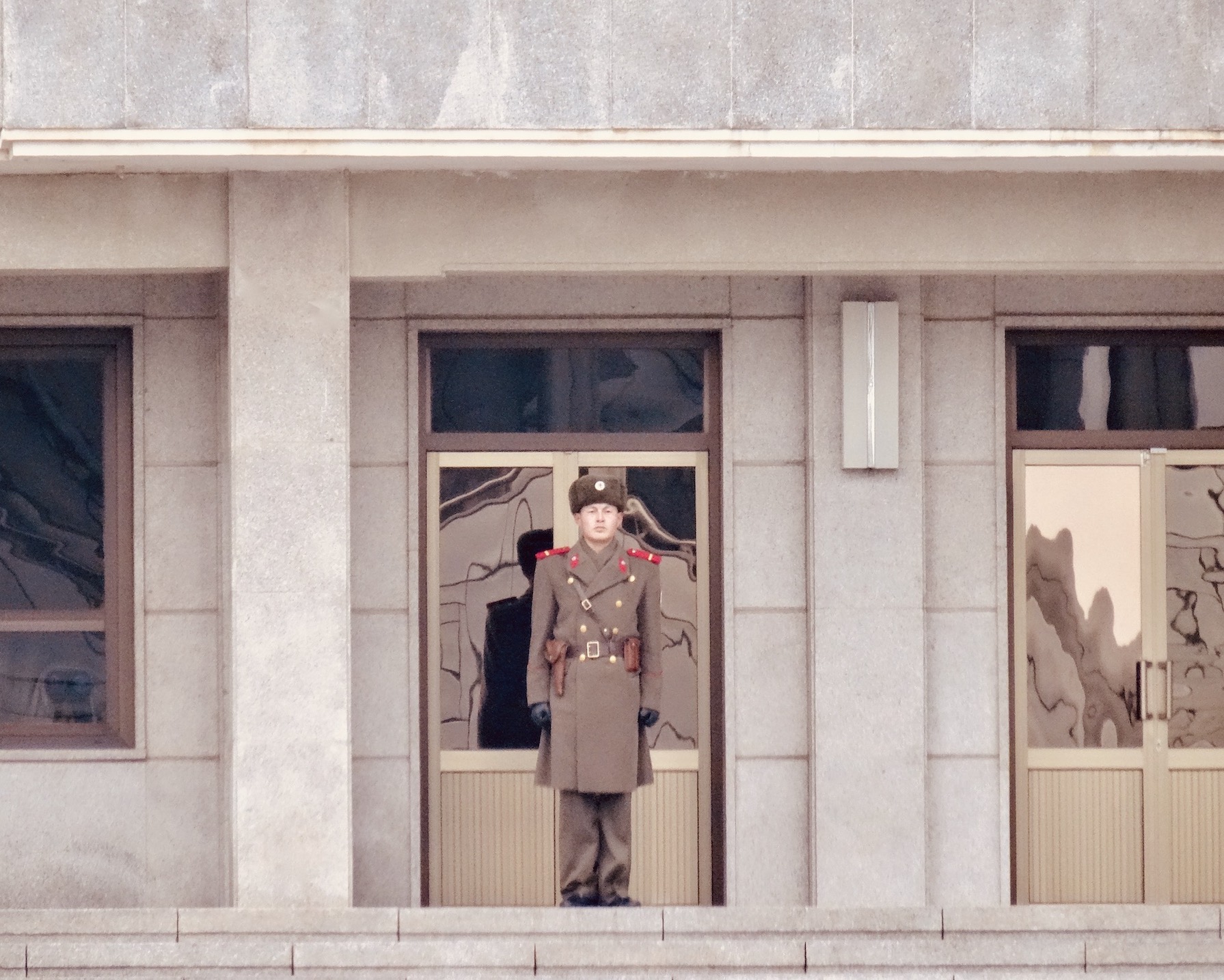
Bob.
Private Alfatino also revealed that the North Korean Soldier standing guard was a familiar face and that on the southern side he’s known as Bob. When I asked what kind of guy Bob was, Alfatino replied: “Nearly four months now and no discernible personality”.

Inside one of the JSA’s blue conference rooms.
Private Alfatino led us into one of the blue conference rooms. “This is where all the diplomatic stuff goes down” he said, as a statuesque, sunglass-wearing soldier stood guard by a window.
“A few military negotiations too, between North Korea and The UN, in the early 90s”.
We’d all gathered around the long wooden table listening, wholly unprepared for his next revelation. “Oh, by the way, those of you standing to the right of the flag, you’re actually in North Korea right now”. I was one of those people and, for reasons I can’t even explain, I felt a sudden thrill.

President Trump and Kim Jong-un. June 30th, 2019.
Photo courtesy of The White House.
Nearly four and a half years after my visit to the JSA, Donald Trump became the first sitting U.S. President to step into North Korea when he briefly moved over the demarcation line during his meeting with North Korean leader Kim Jong-un.
The DMZ, Korea.

Back on the bus.
“Guys, let’s go for a drive, gonna show you some crazy stuff!” exclaimed Private Alfatino. Within minutes we were rumbling down a road through light woodland, flashes of fields and rolling countryside appearing and dissolving through gaps in the trees.

The North Korean Village of Kijong-dong.
Eventually, we got to see clear views of a fake North Korean village called Kijong-dong. It sprang up in the 1950s in an attempt to lure pro-north South Koreans looking to defect.
According to an official statement from The North, the village is home to 200 families who run a collective farm. In addition to homes, they say the village includes a school and a hospital.

The North Korean Village of Kijong-dong.
Gazing out at the village that day, it seemed positively laughable that anybody could believe this was a place where people lived. Firstly, there wasn’t a soul to be seen. Secondly, nearly all of the buildings are windowless.
Indeed, The South states that Kijong-dong exists purely for propaganda purposes. Electric lights operate on a timer, they say, while the occasional maintenance team arrives to sweep the streets in order to create the illusion of an inhabited place.
The Bridge of No Return.

The Bridge of No Return.
Further along, the bus stopped for a look at The Bridge of No Return. This is where prisoner exchanges took place in 1953 in the wake of The Armistice Agreement. The bridge’s name references the final ultimatum given to POWs brought to the bridge for repatriation.
They could either stay in The North as legal citizens, or go back to their homeland. If they chose the latter, they could never return, under any circumstances. I know which option I would have gone for.

JSA Vistor Center.
Our final stop that day was at the JSA Visitor Center, home to a small exhibition on the history of the Joint Security Area. There’s also a gift shop for that all-important DMZ Korea fridge magnet. Outside, in the minutes before our bus was about to head back to Seoul, I chatted with Private Alfatino.
Speaking candidly, he conceded that life at The DMZ was largely uneventful. What’s more, he was eagerly anticipating a post somewhere in The Middle East where he could “do more meaningful work”. I often wonder what became of him.

Interested in visiting The Korean DMZ? There are a bunch of tour options available through Viator.
Like this? Then why not check out my other reports from all around South Korea.
I’ve been living, working and traveling all over the world since 2001. So why not check out my huge library of travel reports from over 30 countries.




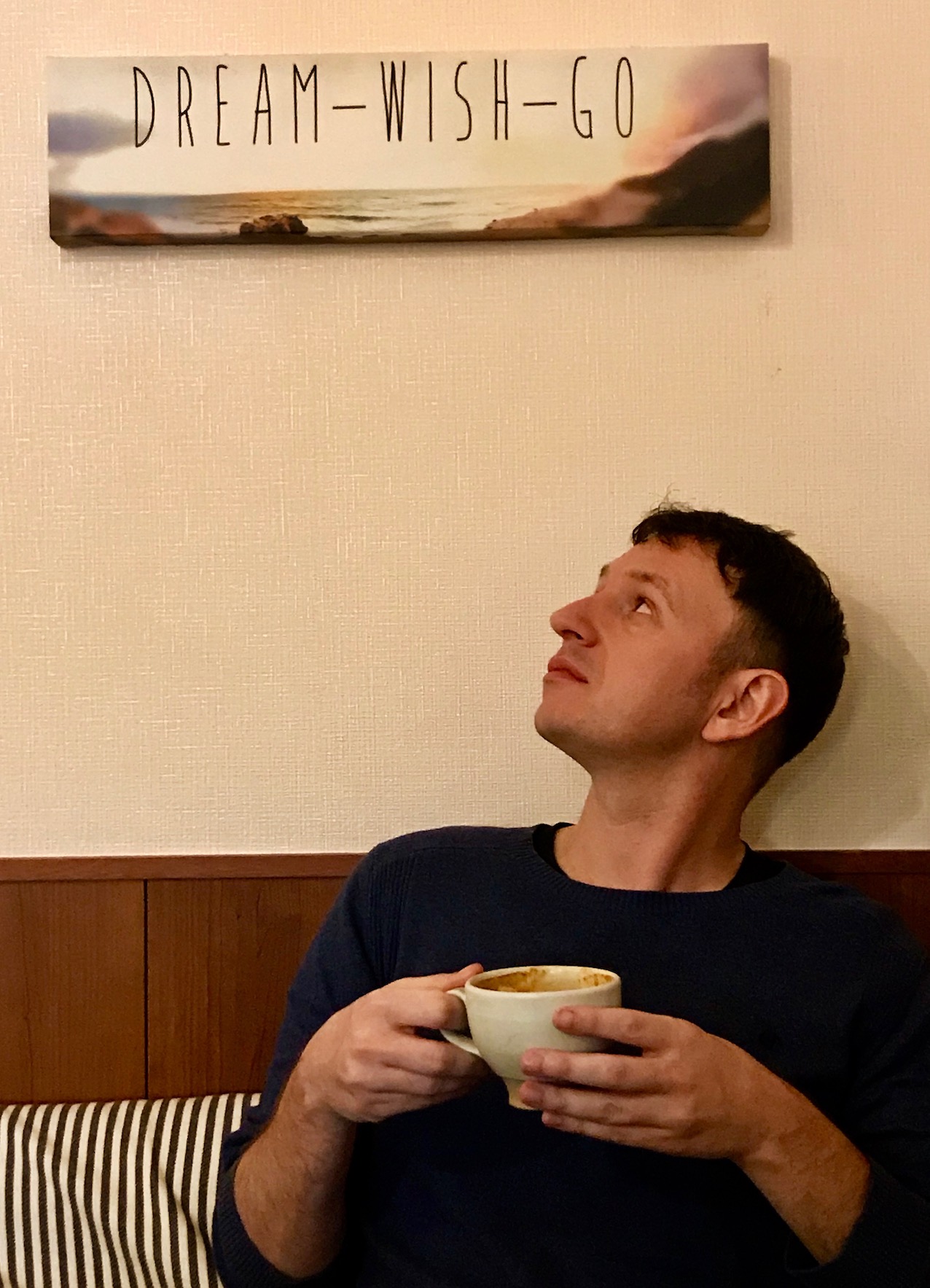


9 Comments
What an extraordinary dreary place. It surely gives us some idea of what North Korea is like.
Certainly interesting and eery place, especially that fake North Korean village. Thanks for sharing!
Thanks for reading!
This was a fascinating read, thanks for sharing your experience!
Thanks Diana, took me a few days to write this one up. I had so many photos.
The whole place looks barely occupied. Too bad you never got to talk to Bob. Thanks for the tour, now I won’t have to go.
I’ve been fascinated with the North-South Korean divide for the past couple of years, considering that I’ve never been to either countries. The DMZ is certainly the hot spot for tourists who want to get a taste of “stepping” into North Korea for a few minutes (and to say that they’ve “been there”). But it’s more than that, as the DMZ is a barrier between the two countries that were torn apart over 60 years ago…who knows when (and if) they’ll be reunited some day.
Thanks for reading! Hope the article succeeded in whetting your appetite for a DMZ visit. It’s a strange, captivating place.
I think I recently stumbled on a vlog on The Korea’s DMZ on YouTube but this, this has done more than enough justice to the indeed eerie location.
I saw the agreement, and it’s true, because a South Korean man was killed around that zone by the Northern counterpart. He was found much later and Kim Jong Un offered a “weeping” apology.
Good to read about Leighton but definitely not on my to-do list.